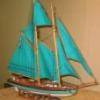MORE HANDBOOKS ARE ON THEIR WAY! We will let you know when they get here.
×
-
Posts
2,583 -
Joined
-
Last visited
Reputation Activity
-
 JSGerson got a reaction from goatfarmer11 in Rattlesnake by JSGerson - FINISHED - Mamoli - 1:64 - Using Robert Hunt’s practicum
JSGerson got a reaction from goatfarmer11 in Rattlesnake by JSGerson - FINISHED - Mamoli - 1:64 - Using Robert Hunt’s practicum
After four courses I decided to also work my way down from the wales to ensure I met the wales properly. Here is where my inexperience began to show. I could already see that some of the planks where going need being split but when and how eluded me. As I stated before reading how to do it and actually doing it is not the same thing. I plodded on. When a holly plank crossed the waterline it was cut at the waterline and continued as boxwood which is slightly darker wood.
-
 JSGerson got a reaction from Torrens in Rattlesnake by JSGerson - FINISHED - Mamoli - 1:64 - Using Robert Hunt’s practicum
JSGerson got a reaction from Torrens in Rattlesnake by JSGerson - FINISHED - Mamoli - 1:64 - Using Robert Hunt’s practicum
The Wales
The practicum explains: The wales are to be made from ebony, it my case black stained walnut. Two rows of planking make up the wales. The first row is attached now and second row later.
“The wales are somewhat different than what we normally see on most ships. There is a definite plank thickness difference in the top wale plank and hull planking. However, the bottom wale plank is flush with the top row of the lower planking. Normally the plank beneath the wales is called the diminishing plank and is slightly thinner than the wales. But on Rattlesnake, the wales are slightly tapered so as to form a smooth flow into the lower planking, no step down as normally seen.”
The first plank of the wale is glued from the stern to the fourth bulkhead from the stern on top of the basswood wale that was installed earlier in Chapter 2
This was continued to the stem.
-
 JSGerson got a reaction from goatfarmer11 in Rattlesnake by JSGerson - FINISHED - Mamoli - 1:64 - Using Robert Hunt’s practicum
JSGerson got a reaction from goatfarmer11 in Rattlesnake by JSGerson - FINISHED - Mamoli - 1:64 - Using Robert Hunt’s practicum
The practicum tells you not to glue the margin plank until the very end. This way, you can remove that plank, to make the plank notches. The planks themselves are glued in. Finally at the end the margin plank is glued down.
The trick is to, as the practicum puts it: “You want to have exactly 3 rows of planking left to install between the last row and the margin plank you have just cut. The aft end of the next row of planking you install will nib into the margin plank at the aft end about 1/4" from the end.”
Mine was close but not exact…as usual.
Tree Nails
The deck planks have a single 026” treenail across its width and are installed as before on the beam lines into #69 drill bit holes. Bamboo nails are made using a draw plate and “glued” in using poly-wipe.
-
 JSGerson got a reaction from Torrens in Rattlesnake by JSGerson - FINISHED - Mamoli - 1:64 - Using Robert Hunt’s practicum
JSGerson got a reaction from Torrens in Rattlesnake by JSGerson - FINISHED - Mamoli - 1:64 - Using Robert Hunt’s practicum
Bulwarks Planking and Deck Clamps
Depending on what bulwark method used determined the thickness of the planking strips. In my case, it was 1/32” x 3/32” swiss pear. Staring from the stern and staggering the joints, the planking was installed.
-
 JSGerson got a reaction from goatfarmer11 in Rattlesnake by JSGerson - FINISHED - Mamoli - 1:64 - Using Robert Hunt’s practicum
JSGerson got a reaction from goatfarmer11 in Rattlesnake by JSGerson - FINISHED - Mamoli - 1:64 - Using Robert Hunt’s practicum
Following the instructions of the practicum, I installed the tree nails using Minwax Wipeon Poly as the adhesive. This is the same coating used to finish the wood surface of the boat. The excess bamboo is cut off and sanded flush leaving no glue marks. I prefer that the treenails have a low contrast rather high one as seen in some other models because I feel it looks more realistic. The picture below shows the bamboo “glued in” but not trimmed and sanded.
-
 JSGerson got a reaction from goatfarmer11 in Rattlesnake by JSGerson - FINISHED - Mamoli - 1:64 - Using Robert Hunt’s practicum
JSGerson got a reaction from goatfarmer11 in Rattlesnake by JSGerson - FINISHED - Mamoli - 1:64 - Using Robert Hunt’s practicum
Because some of the gunports have lids and others don’t, a lip had to be constructed around the openings for those that did. Here is a picture from the practicum as I do not have a picture that depicts it.
-
 JSGerson got a reaction from goatfarmer11 in Rattlesnake by JSGerson - FINISHED - Mamoli - 1:64 - Using Robert Hunt’s practicum
JSGerson got a reaction from goatfarmer11 in Rattlesnake by JSGerson - FINISHED - Mamoli - 1:64 - Using Robert Hunt’s practicum
In this instance the alignment used the kit bullheads. If they were off… ripples and ripple effect.
-
 JSGerson got a reaction from goatfarmer11 in Rattlesnake by JSGerson - FINISHED - Mamoli - 1:64 - Using Robert Hunt’s practicum
JSGerson got a reaction from goatfarmer11 in Rattlesnake by JSGerson - FINISHED - Mamoli - 1:64 - Using Robert Hunt’s practicum
CHAPTER 2 – The Upper Hull, Scratchbuilt
Upper Planking
The wales
Mr. Hunt addresses and emphasizes the key in model ship construction is that everything is dependent and related to each other. It’s the ripple effect. You do things right, and things go easier; you do them poorly, not so well. I did not realize at the time, how I would learn the truth of that. With that said, I started my first real planking process.
The practicum starts at the wales. Using the Hahn profile drawing, I cut out drawing and pasted it to card stock – office file folder. Following the instructions of the practicum, the template was located and placed on the model careful to keep it flat. That meant to NOT wrap it around the hull. The 2D image on the template was what one would see looking from the side, not the actual 3D shape. I had this problem earlier with the transom window openings. The wale line was then marked in pencil on the hull. This was repeated on the port side with the template reversed.
-
 JSGerson got a reaction from Torrens in Rattlesnake by JSGerson - FINISHED - Mamoli - 1:64 - Using Robert Hunt’s practicum
JSGerson got a reaction from Torrens in Rattlesnake by JSGerson - FINISHED - Mamoli - 1:64 - Using Robert Hunt’s practicum
You will noticed that I had not finished carving the stern and transom
The next thing was to shorten is Part 22.
-
 JSGerson got a reaction from goatfarmer11 in Rattlesnake by JSGerson - FINISHED - Mamoli - 1:64 - Using Robert Hunt’s practicum
JSGerson got a reaction from goatfarmer11 in Rattlesnake by JSGerson - FINISHED - Mamoli - 1:64 - Using Robert Hunt’s practicum
After cleaning the edges and test fitting the pieces, looking for gaps, etc. the edges were darkened with artist charcoal to simulate tar chalking. The pieces were then glued together using another uncut copy of the stem as a template. Now the stem looks like what the shipwright would have seen when they completed the stem on the actual ship.
As Mr. Hunt points out, if I were to place my new stem on top the kit’s plan they don’t exactly match. Not only that, the kit’s figurehead won’t fit either but that’s OK because I jumped in with both feet on this build which means I will be carving a new figurehead from scratch when the time comes.
-
 JSGerson got a reaction from yvesvidal in Rattlesnake by JSGerson - FINISHED - Mamoli - 1:64 - Using Robert Hunt’s practicum
JSGerson got a reaction from yvesvidal in Rattlesnake by JSGerson - FINISHED - Mamoli - 1:64 - Using Robert Hunt’s practicum
Belay Pins
Although the Practicum doesn't call for the belay pins to be installed at this stage, I thought it wise to do so while it was still free and clear of any other items that may be in the way later. The belay pins were insert and glued to the forecastle top rails. It was at this point I realized that I had forgotten to drill the belay pin holes in the forecastle center rail. Well, it wasn't done for the quarterdeck center rail and I had to drill those, so I hoped it wouldn't be too big a problem now. I marked to position for the holes with a pin and drilled pilot holes for eight pins in the quarterdeck center rail figuring the rail is a delicate structure. I didn't want to put too much pressure on it. Then I drilled the holes again so that the belay pins would fit. Surprisingly, this worked without a hitch. Once the forecastle center rail was solidly glued, the same process was repeated only this time there were only six belay pins according to the Practicum. What was weird here is the Practicum showed all three pins (per side) in between two stanchions. The Mamoli plan showed two pins. I went with the Mamoli plans because three pins seemed a bit crowded and two pin holes between stanchions also matched the quarterdeck center rail. I installed only six belay pins as per the Practicum. If need be I can install more as the holes for the pins have been drilled.
-
 JSGerson got a reaction from yvesvidal in Rattlesnake by JSGerson - FINISHED - Mamoli - 1:64 - Using Robert Hunt’s practicum
JSGerson got a reaction from yvesvidal in Rattlesnake by JSGerson - FINISHED - Mamoli - 1:64 - Using Robert Hunt’s practicum
And before the CA glue completely set, both completed rail assemblies were installed onto the bow. This allowed me a little wiggle room to insert the brass pegs on the bottom of the stanchions into the holes on the bow and make any necessary adjustments.
While the CA glue for the forecastle top rails was setting up, the forecastle center rail was installed.
-
 JSGerson got a reaction from yvesvidal in Rattlesnake by JSGerson - FINISHED - Mamoli - 1:64 - Using Robert Hunt’s practicum
JSGerson got a reaction from yvesvidal in Rattlesnake by JSGerson - FINISHED - Mamoli - 1:64 - Using Robert Hunt’s practicum
You will notice in the image of the rails above there are markings for drilling the stanchion tenon and belay pin holes. First the stanchion holes were drilled and dry fitted with the stanchions. This in turn was dry fitted to the bow. The image below shows just the starboard. The same was done for the port side.
-
 JSGerson got a reaction from Martin W in Rattlesnake by JSGerson - FINISHED - Mamoli - 1:64 - Using Robert Hunt’s practicum
JSGerson got a reaction from Martin W in Rattlesnake by JSGerson - FINISHED - Mamoli - 1:64 - Using Robert Hunt’s practicum
Thanks for the picture.
I really don't think the cleats are that important. It seems that everybody's model are a bit different for each other and who is to say which is correct. Ships change over time due to captain's whim, use, battle damage, and plain wear and tear. If I have to install them some time in the future, I could do it your way and place the cleats on the deck or smooth off the bottom (to avoid drilling) of the cleats and use just a fine dab of epoxy to apply it to the stanchions.
-
 JSGerson got a reaction from goatfarmer11 in Rattlesnake by JSGerson - FINISHED - Mamoli - 1:64 - Using Robert Hunt’s practicum
JSGerson got a reaction from goatfarmer11 in Rattlesnake by JSGerson - FINISHED - Mamoli - 1:64 - Using Robert Hunt’s practicum
Because the wale is thicker than the rest of the planking, the wale is double planked. The first layer is basswood and the second ebony. My wood package did not come with ebony, but walnut which I had to paint black. This first planking will obviously not be seen so the practicum has it applied as one piece. After it was fitted and beveled to fit in the bow rabbet joint, it was glued down working my way back to the stern.
-
 JSGerson got a reaction from themadchemist in Rattlesnake by JSGerson - FINISHED - Mamoli - 1:64 - Using Robert Hunt’s practicum
JSGerson got a reaction from themadchemist in Rattlesnake by JSGerson - FINISHED - Mamoli - 1:64 - Using Robert Hunt’s practicum
I then went and installed the catheads
-
 JSGerson got a reaction from Jaxboat in USS Constitution by BRiddoch - Model Shipways - Scale 1:76
JSGerson got a reaction from Jaxboat in USS Constitution by BRiddoch - Model Shipways - Scale 1:76
I asked my nephew this question about the copper tape. He works for a company in Japan (he speaks very fluent Japanese) that deals with adhesives and coatings, matching buyers with sellers of these various products. In other words they match the problem with a solution. He does all their technical translations into English as well as maintain their website. He is NOT a model builder however. He responded:
Good question. I've actually never come across copper tape before, but I'll look into it. It's something we don't cover specifically, and if I haven't come across it, that probably means we've never covered it. That said, I can tell you all kinds of things you never knew (or wanted to know) about copper tape. You are correct in assuming that no tape lasts forever. Under specific conditions (mostly sealed conditions) it can last years, even decades. They use all sorts of tapes in construction now, but that is usually for temporarily holding things together until something more permanent is used (screws, etc.). But in a sealed environment, such as that inside an aluminum window frame, it will last as long as your house is standing. In fact, those tapes are often used for waterproofing and not as a structural element, so must be virtually immune to water and moisture. But the big problem with adhesive tapes is two fold. The first is that most are pressure-sensitive, which means they don't even try to be permanent. The second is that it really depends on what you are taping (the adherent). I am assuming you will be working with wood, and very porous wood at that. This means that oxygen will reach the adhesive layer relatively easily, and quickly. This will oxidize the adhesive (not to mention the copper itself), and cause it to become gooey or dry out, depending on the adhesive agent. The difficulty is in finding a copper tape that uses the right adhesive agent for the adherent. Most stick to wood pretty well because wood is rough, but before applying the tape, make sure there is as little dust as possible. This will increase the life of the tape. You could also put a transparent sealant over the tape to increase it's life. I assume you would add a sealant to the ship anyway, so you would want to do this after applying the tape (granted, the solvent in the sealant could dissolve the adhesive, just as the solvent in the adhesive could dissolve the paint it is on and cause delamination). In the Tiffany lamps, the solder is basically used to seal the tape so that oxygen does not reach the adhesive agent. Copper tape is used because copper is heat resistant and conductive and can thus withstand the soldering temperature and bond well with the solder itself. I doubt you could solder copper tape on a wood surface, though. Not that you would want to anyway for the application you are considering. From my understanding of how adhesive tape works and knowing that you would not be working in a nice environmentally controlled area with pressure gradients to whisk away dust as you worked, I would find an alternative. Tape is what is usually called a PSA (pressure sensitive adhesive) and is thus always in a moist state. So I would use a true adhesive that dries completely and copper foil strips. I know that would be more difficult, but if you want it to last years, or decades, to me that seems like the better option. I'll see if I can find anything on existing tapes in terms of durability, but I have a feeling that copper tape is not designed to be applied to wood or organic surfaces (paint, etc), so I would recommend against it. I don't know if I have opened a can of worms, muddied the waters, and befuddled everyone. Let's see if he can come up with a more definitive answer.I would hate to have to glue individual strips with CA glue to get long lasting results. -
 JSGerson got a reaction from maso in Rattlesnake by JSGerson - FINISHED - Mamoli - 1:64 - Using Robert Hunt’s practicum
JSGerson got a reaction from maso in Rattlesnake by JSGerson - FINISHED - Mamoli - 1:64 - Using Robert Hunt’s practicum
The pieces were then cutout using my old Dremel scroll saw and finally glued into place. This was not as easy as it appeared. I had a devil of a time getting all the pieces to fit right. I even had to make two of template pieces over again. I got it to work and accepted it, but still not really truly satisfied. If you look closely, where the left scarf joint broke during the cutting process. I got it mended OK, but couldn’t remove all of the glue stains.
-
 JSGerson got a reaction from maddog33 in Rattlesnake by JSGerson - FINISHED - Mamoli - 1:64 - Using Robert Hunt’s practicum
JSGerson got a reaction from maddog33 in Rattlesnake by JSGerson - FINISHED - Mamoli - 1:64 - Using Robert Hunt’s practicum
Once dry fitted, sanded, and finished with Wipe-on Poly, they were installed.
-
 JSGerson got a reaction from goatfarmer11 in Rattlesnake by JSGerson - FINISHED - Mamoli - 1:64 - Using Robert Hunt’s practicum
JSGerson got a reaction from goatfarmer11 in Rattlesnake by JSGerson - FINISHED - Mamoli - 1:64 - Using Robert Hunt’s practicum
For all intents and purposes, the Quarterdeck is complete...at least for now.
-
 JSGerson got a reaction from janos in Rattlesnake by JSGerson - FINISHED - Mamoli - 1:64 - Using Robert Hunt’s practicum
JSGerson got a reaction from janos in Rattlesnake by JSGerson - FINISHED - Mamoli - 1:64 - Using Robert Hunt’s practicum
Once dry fitted, sanded, and finished with Wipe-on Poly, they were installed.
-
 JSGerson got a reaction from mtaylor in Rattlesnake by JSGerson - FINISHED - Mamoli - 1:64 - Using Robert Hunt’s practicum
JSGerson got a reaction from mtaylor in Rattlesnake by JSGerson - FINISHED - Mamoli - 1:64 - Using Robert Hunt’s practicum
Once dry fitted, sanded, and finished with Wipe-on Poly, they were installed.
-
 JSGerson got a reaction from Senior ole salt in Rattlesnake by JSGerson - FINISHED - Mamoli - 1:64 - Using Robert Hunt’s practicum
JSGerson got a reaction from Senior ole salt in Rattlesnake by JSGerson - FINISHED - Mamoli - 1:64 - Using Robert Hunt’s practicum
There is a curve handrail from the upper stanchion to the quarterdeck fore rail. Using a copy of the rails from the Hahn’s deck plans to make a template, it was rubber cemented to 1/32” x 5/32” swiss pear. The Practicum however called for 1/32” x 3/32”. I couldn’t see how that would work. If may be as a result the dimension change I made when constructing the quarterdeck fore rail. The pieces were then cut out, trimmed and fitted. The upper surface of the handrail hand the upper edge rounded over while the bottom was kept flat.
-
 JSGerson got a reaction from maddog33 in Rattlesnake by JSGerson - FINISHED - Mamoli - 1:64 - Using Robert Hunt’s practicum
JSGerson got a reaction from maddog33 in Rattlesnake by JSGerson - FINISHED - Mamoli - 1:64 - Using Robert Hunt’s practicum
The construction process however is the same as before including the pin the bottom of the stanchion to help affix it to the gangplank.
-
 JSGerson got a reaction from Senior ole salt in Rattlesnake by JSGerson - FINISHED - Mamoli - 1:64 - Using Robert Hunt’s practicum
JSGerson got a reaction from Senior ole salt in Rattlesnake by JSGerson - FINISHED - Mamoli - 1:64 - Using Robert Hunt’s practicum
Before I added the planks, the edge of the bulwarks had to be finished so that the rails by the gangplanks could be installed. A piece of swiss pear wood was installed in the end of the bulwark to provide the finished look. The planking was then installed. After the pictures below were taken, removed them and replaced them with a wider piece.











